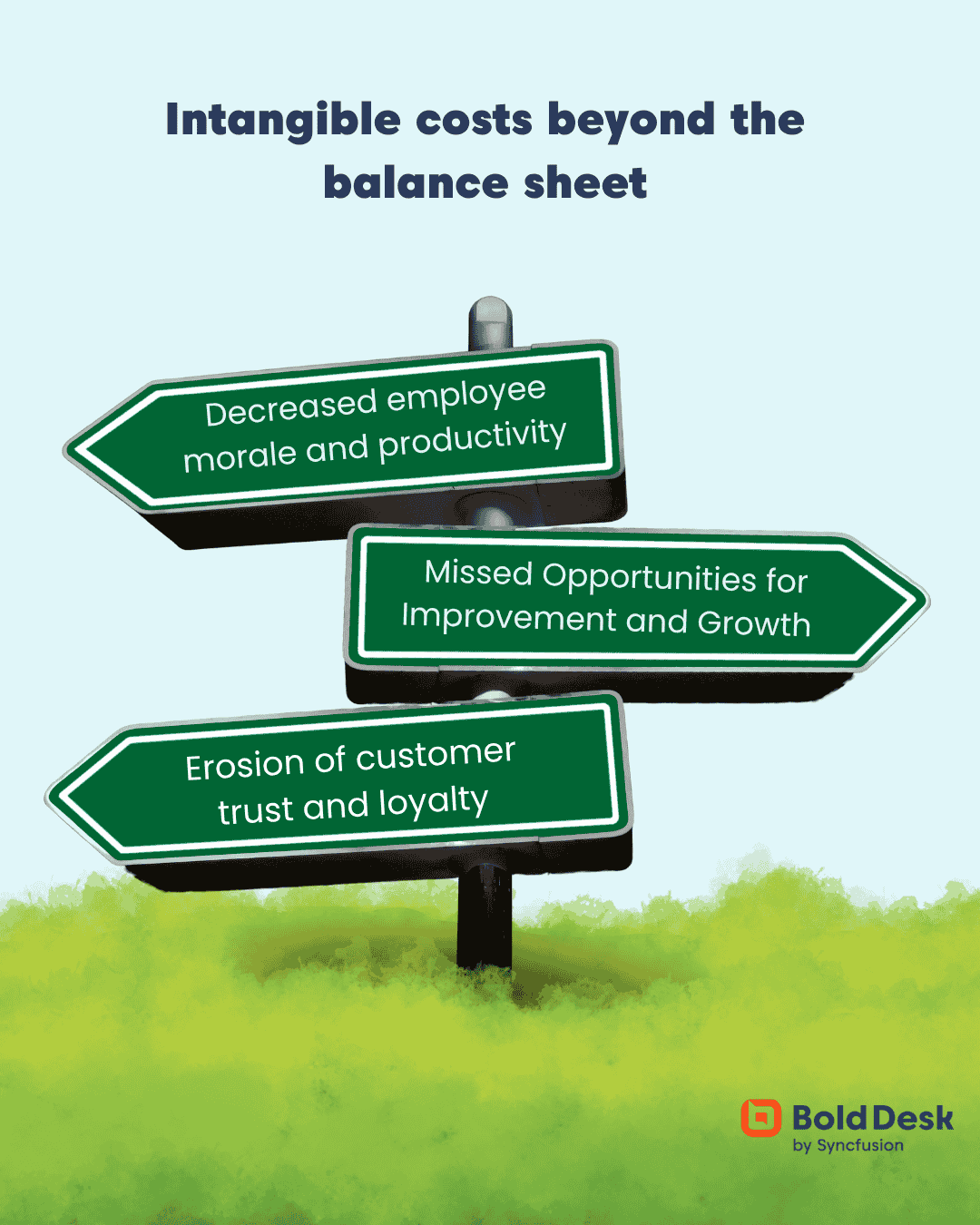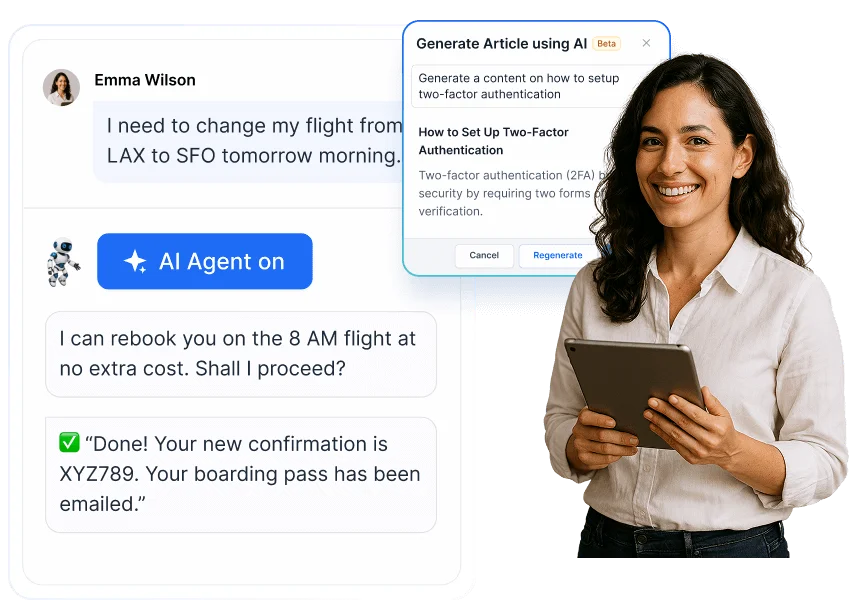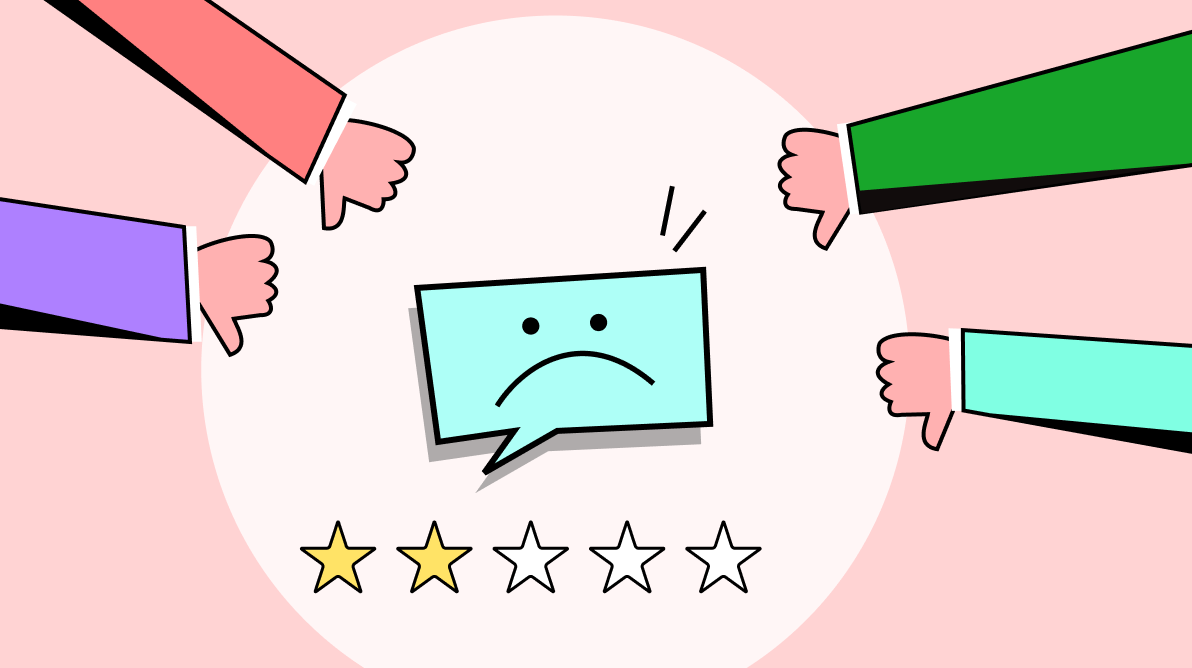In a successful business, customer support is more than just a department; it’s a vital part of the foundation.
If this foundation is weak, the entire business can be at risk. Poor customer support may seem minor, but it can result in significant issues like lost revenue, talent, and brand reputation.
Some leaders see customer support costs as something to cut. But in reality, good support helps keep customers happy and loyal.
This outdated view fails to recognize the importance of every customer interaction, which can either enhance loyalty or push customers to competitors.
In this guide, we’ll discuss the cost of poor customer support on revenue, employee morale, and customer trust. We will also provide a strategic investment plan for enhancing your customer support experience.
What is poor customer support?
Poor customer support is when a company fails to respond effectively to customer needs, causing confusion, frustration, and a loss of trust in the service.
It signifies a core failure to deliver prompt, effective, and empathetic help, which ultimately leaves customers feeling ignored and undervalued. A decline in customer satisfaction is a common result.
This issue is not merely a flawed process; rather, it generates a negative perception of poor customer support that becomes linked with the brand itself.
Examples of poor customer support:
These examples highlight the common pitfalls of poor customer support:
- Long wait times: Keeping customers on hold for too long or providing delayed email responses.
- Repeated information requests: Requiring customers to repeat issues and details to different agents.
- Issue not resolved after multiple conversations: Failing to solve problems in the initial stages of conversations, which requires more follow-ups.
- Missing personal connection: Support relies on scripts and automation, often lacking empathy and a human touch.
- Lack of product knowledge: Employing poorly trained support teams that give unclear or unhelpful answers.
- Not listening to customer concerns or feedback: When support agents ignore or dismiss customers’ concerns, it leads to frustration and unresolved issues. Customers feel undervalued, and their feedback, which could enhance service, is overlooked.
The Tangible costs: how poor customer support impacts your bottom line
Let’s shift the lens from emotions to economics. Poor customer support isn’t just a soft issue; it has tangible financial impacts that show up right on your balance sheet.

This is when poor customer service stops being just a concern and starts directly impacting your bottom line.
Increased customer churn and lost revenue
When customers have a bad experience with poor customer support, they feel pushed to leave the company in search of better service elsewhere.
This customer churn is the most direct way that poor customer service diminishes your revenue, as each lost customer represents a loss of all their future income.
According to McKinsey, reducing churn by just 5% can boost profits by 25% to 95% in high-touch industries like healthcare and financial services.
Example:
Imagine a SaaS company that fails to respond promptly to customer support tickets. Frustrated users cancel their subscriptions and share negative reviews online. Within months, the company sees a 15% drop in retention and a 20% decline in monthly revenue due to its poor customer support.
- Pro tip: Don’t wait for complaints; create responsive and knowledgeable support teams. Regularly track KPI’s like CSAT and NPS metrics to monitor customer experiences. Proactive support helps identify issues early and prevent customer churn.
Higher operational expenses
Decline of customer support drives customers away and creates internal problems. Inefficient processes and unresolved issues force your team to work harder, unnecessarily increasing costs.
Example: A software company with a clunky support system receives repeated tickets for the same issue. Since problems aren’t resolved efficiently, support agents spend extra hours handling follow-ups, escalating cases, and calming frustrated customers, driving up labor costs and reducing productivity. This is a significant part of the cost of poor customer support.
- Pro tip: Use a smart knowledge base and AI-powered chatbots to handle common questions and routine tasks. This frees up your support team to focus on complex, high-value issues.
Negative brand reputation and reduced CLTV
In today’s digital world, one unhappy customer can do a lot of damage. A single negative review or a viral post about poor customer support can damage your brand’s reputation.
This can drive away potential customers and reduce the value of existing ones.
A press release by Calabrio states that 97% of consumers and 98% of contact center managers say customer service interactions impact whether consumers stay loyal to a brand. A decline in customer satisfaction is a direct result of poor customer service.
Example: A customer once tweeted about a bad experience with a food delivery app. The post went viral, and many users started sharing similar complaints. The company lost trust, saw fewer new sign-ups, and existing users stopped ordering as often.
- Pro tip: Reply to unhappy customers quickly and publicly. A sincere apology and a clear fix can turn a bad moment into a chance to build trust and protect your brand’s reputation and customer value.
Legal and compliance risks
Legal and compliance risks can significantly undermine the quality of customer service.
These issues often manifest in ways that are not immediately visible to customers, leading to long-term consequences for both the business and its customers.
Over time, such issues can erode customer trust, diminish customer satisfaction, and harm the company’s reputation.
Example: A company collected customer data without proper consent. When regulators found out, the company was fined heavily for violating privacy laws. This also damaged customer trust and led to a drop in sales.
- Pro tip: Be aware of the regulations in every area where you conduct business. What is permitted in one location may be prohibited in another. Adhere to privacy laws to prevent penalties and safeguard your brand, particularly regarding customer information.
The intangible costs: beyond financial statements
Not all damage can be measured in money, but it’s still real. Poor customer support leads to hidden costs that harm your company culture and weaken customer relationships.

These hidden costs can eventually lead to real business problems, serving as the underlying conditions for the financial losses we’ve already discussed. This contributes to the overall cost of poor customer support.
Decreased employee morale and productivity
Your customer support team plays a key role in your brand’s success. When employees are equipped with outdated tools and often face unhappy customers because of insufficient support, it can create a stressful work environment.
This situation may lead to low morale and increased staff turnover.
Example: A telecom company used outdated support tools that often crashed. Support agents had to deal with frustrated customers during service outages, which caused stress and burnout. Many employees quit, leading to poor service and a drop in customer satisfaction.
- Pro Tip: Equip your support team with reliable tools and regular training. A well-supported team stays motivated, handles customer issues better, and helps maintain a strong brand reputation.
Missed Opportunities for Improvement and Growth
When customer complaints about poor customer service are ignored, businesses risk losing valuable insights that could improve their products or services and uncover new growth opportunities.
According to the Temkin Group, 90% of companies with strong customer experience leadership report higher levels of customer satisfaction.
Example:A mid-sized e-commerce company received frequent support tickets about product quality and late deliveries. But the team didn’t review the feedback regularly. As a result, customer complaints increased, and repeat purchases dropped.
- Pro tip: Review customer complaints regularly. They often reveal problems you can fix to improve your service and grow your business.
Erosion of customer trust and loyalty
Trust is built through honest, consistent communication. When businesses fail to be transparent, especially during support interactions, it can quickly erode customer loyalty and damage brand reputation.
This can result in lost customers, negative reviews, and long-term damage to your brand and reputation.
A Notmi’s study found that in the U.S., 59% of customers will leave a brand after multiple poor experiences—even if they love the company—and 17% will leave after just one.
Example: A subscription-based software company experienced a system outage that affected many users. Instead of informing customers promptly, they stayed silent. Frustrated by the lack of updates, several users canceled their subscriptions and left negative reviews, citing poor communication and lack of accountability.
- Pro tip: Be upfront when things go wrong. A quick, honest update, even if you don’t have all the answers, shows customers you respect them. Transparency builds trust, even in tough situations.
Strategies to reduce support costs with smarter solutions
The costs of poor customer support can be high, but they are avoidable. By investing in better processes and technology, you can transform your support team into a valuable resource for growth and customer loyalty.

These strategies work best together, creating a strong support system that saves money and builds loyalty, helping your business grow.
Enhance customer service culture
A truly customer-focused culture begins when everyone from frontline agents to leadership shares the same commitment to customer service.
When teams align their values, goals, and actions around the customer experience, support becomes more consistent, empathetic, and effective.
Cross-functional collaboration plays a key role in this. When every department works together with customer satisfaction as a shared goal, it creates a unified and seamless approach to service delivery.
In such an environment, delivering great customer experiences becomes a shared responsibility. Everyone feels accountable, empowered, and motivated to contribute to positive outcomes
Result: Stronger team morale leads to greater customer loyalty. This not only builds trust and encourages repeat business but also enhances employee satisfaction and improves retention across the organization
Regular training to support the team (soft and hard skills)
Investing in continuous training equips your team with both the technical expertise to understand your product or service and the interpersonal skills needed to engage customers effectively.
This dual focus empowers agents to handle complex issues with confidence and respond quickly, reducing the risk of poor customer experiences.
Ongoing training also ensures your team stays current with evolving tools, updated processes, and best practices in communication..
Result: Skilled agents lead to smoother resolutions. With stronger expertise, they solve problems faster, reduce the need for escalations, and contribute to a more confident and capable support team
Preparing support teams for constructive responses
Every successful business receives both praise and criticism; it’s part of growth. Addressing negative feedback regarding poor customer support demonstrates accountability.
Being transparent and focusing on solutions shows a commitment to customer satisfaction and provides opportunities to enhance your service.
Result: Rebuilding trust strengthens your brand reputation and identity. Addressing negative feedback with transparency not only turns dissatisfied users into loyal advocates but also enhances your reputation among potential customers who read reviews.
Utilizing the right tools and technologies
Empower your support team with the right tools to work smarter, not harder. Modern solutions reduce repetitive tasks, streamline workflows, and allow agents to focus on solving complex issues efficiently.
- Advanced Ticketing System – Organizes and prioritizes customer issues for faster resolution.
- CRM Integration – Provides a complete view of customer history to personalize support.
- AI Assistance – Offers smart suggestions and automates routine responses.
- Omnichannel Support – Enables seamless communication across chat, email, social media, and more.
- Automation – Handles repetitive tasks like routing and follow-ups to save time.
Result: Faster service with less manual effort leads to quicker response times and more accurate support, ensuring customers receive timely and reliable help.
Streamline support with a unified knowledge system
Create a centralized, searchable system to store your company’s knowledge. This ensures your team has instant access to accurate, up-to-date information, helping them assist customers more effectively.
A well-maintained knowledge base, along with organized FAQs, allows both agents and customers to quickly find reliable answers, reducing support delays and improving overall service quality.
Result: Faster answers, more consistent support. By reducing ticket volume and improving first-contact resolution, your team can deliver timely, accurate help across all channels, building trust and efficiency at every touchpoint.
Collect customer feedback and get insights to improve
Use surveys, reviews, and analytics to gather real-time feedback from your customers. Analyze trends to identify customer challenges and customer pinpoint areas for improvement in the business based on that feedback. Improving customer satisfaction should be the goal.
Result: Smarter decisions lead to better service. Customer feedback highlights what’s working and what needs improvement. By acting on these insights, you can refine internal processes, enhance your product or service, and deliver a more personalized and effective customer experience.
The Cost of Poor Customer Service: A Wake-Up Call
Every customer interaction shapes how people see your brand. As this report shows, when support fails, it doesn’t just lead to one unhappy customer—it can cause real financial losses and damage trust and loyalty. The cost of poor customer service is a serious issue.
The solution? Treat every support ticket as a chance to improve. By using smart tools and data-driven strategies, you can turn customer feedback into a guide for growth instead of a list of problems arising from poor customer support.
If you’re ready to gain control over your support operations, BoldDesk provides a single platform to unify every customer interaction.
Its powerful reporting gives you the clarity to track key metrics and turn valuable insights into action. Take control of your customer experience with BoldDesk now!
What is the one recurring issue your support team constantly tackles that leads to perceptions of poor customer support? Let us know in the comments below.
Related articles
- 11 Examples of Bad Customer Service and How to Fix Them
- 11 Best Ways to Handle Angry Customers Effectively (+Templates)
Frequently asked questions
Great customer service is built on a foundation of essential qualities. Here are the 5 key qualities of great customer service:
- Patience – Staying calm and composed, especially when customers are upset or confused.
- Empathy – Understanding and acknowledging the customer’s feelings and perspective.
- Clear Communication – Explaining solutions in a simple, friendly, and professional manner.
- Problem-solving skills – Quickly identifying issues and finding effective resolutions.
- Product knowledge – Having a deep understanding of the product or service to provide accurate help.
- Aggressive customers – Often loud, demanding, and confrontational. They require calm, firm, and respectful handling.
- Indecisive customers – Struggle to make decisions and may need extra guidance and reassurance.
- Know-it-all customers – Believe they know more than the support team and may challenge your expertise. Handle them with respect and facts.
- Frequently complains or argues without valid reasons
- Disrespects staff or company policies
- Makes unrealistic or excessive demands
- Refuses to listen or cooperate
- Repeatedly causes delays or disruptions



















 Email Ticketing System
Email Ticketing System Shared Inbox Software
Shared Inbox Software Multi Brand Help Desk
Multi Brand Help Desk Internal Help Desk Software
Internal Help Desk Software Trouble Ticketing Software
Trouble Ticketing Software Mobile Help Desk
Mobile Help Desk 














